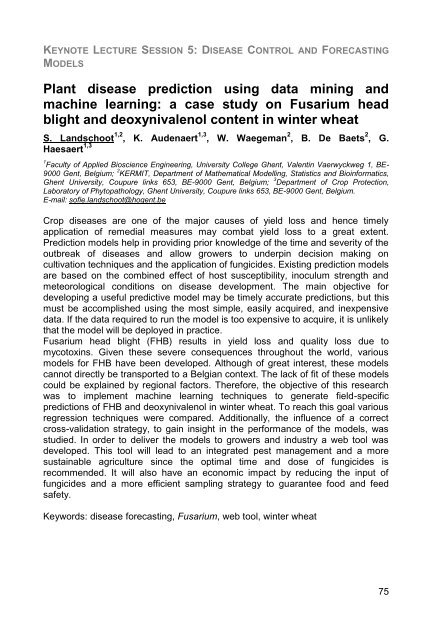EFS12- Book of abstracts - Contact
EFS12- Book of abstracts - Contact
EFS12- Book of abstracts - Contact
Create successful ePaper yourself
Turn your PDF publications into a flip-book with our unique Google optimized e-Paper software.
KEYNOTE LECTURE SESSION 5: DISEASE CONTROL AND FORECASTING<br />
MODELS<br />
Plant disease prediction using data mining and<br />
machine learning: a case study on Fusarium head<br />
blight and deoxynivalenol content in winter wheat<br />
S. Landschoot 1,2 , K. Audenaert 1,3 , W. Waegeman 2 , B. De Baets 2 , G.<br />
Haesaert 1,3<br />
1 Faculty <strong>of</strong> Applied Bioscience Engineering, University College Ghent, Valentin Vaerwyckweg 1, BE-<br />
9000 Gent, Belgium; 2 KERMIT, Department <strong>of</strong> Mathematical Modelling, Statistics and Bioinformatics,<br />
Ghent University, Coupure links 653, BE-9000 Gent, Belgium; 3 Department <strong>of</strong> Crop Protection,<br />
Laboratory <strong>of</strong> Phytopathology, Ghent University, Coupure links 653, BE-9000 Gent, Belgium.<br />
E-mail: s<strong>of</strong>ie.landschoot@hogent.be<br />
Crop diseases are one <strong>of</strong> the major causes <strong>of</strong> yield loss and hence timely<br />
application <strong>of</strong> remedial measures may combat yield loss to a great extent.<br />
Prediction models help in providing prior knowledge <strong>of</strong> the time and severity <strong>of</strong> the<br />
outbreak <strong>of</strong> diseases and allow growers to underpin decision making on<br />
cultivation techniques and the application <strong>of</strong> fungicides. Existing prediction models<br />
are based on the combined effect <strong>of</strong> host susceptibility, inoculum strength and<br />
meteorological conditions on disease development. The main objective for<br />
developing a useful predictive model may be timely accurate predictions, but this<br />
must be accomplished using the most simple, easily acquired, and inexpensive<br />
data. If the data required to run the model is too expensive to acquire, it is unlikely<br />
that the model will be deployed in practice.<br />
Fusarium head blight (FHB) results in yield loss and quality loss due to<br />
mycotoxins. Given these severe consequences throughout the world, various<br />
models for FHB have been developed. Although <strong>of</strong> great interest, these models<br />
cannot directly be transported to a Belgian context. The lack <strong>of</strong> fit <strong>of</strong> these models<br />
could be explained by regional factors. Therefore, the objective <strong>of</strong> this research<br />
was to implement machine learning techniques to generate field-specific<br />
predictions <strong>of</strong> FHB and deoxynivalenol in winter wheat. To reach this goal various<br />
regression techniques were compared. Additionally, the influence <strong>of</strong> a correct<br />
cross-validation strategy, to gain insight in the performance <strong>of</strong> the models, was<br />
studied. In order to deliver the models to growers and industry a web tool was<br />
developed. This tool will lead to an integrated pest management and a more<br />
sustainable agriculture since the optimal time and dose <strong>of</strong> fungicides is<br />
recommended. It will also have an economic impact by reducing the input <strong>of</strong><br />
fungicides and a more efficient sampling strategy to guarantee food and feed<br />
safety.<br />
Keywords: disease forecasting, Fusarium, web tool, winter wheat<br />
75
















![Présentation CRB-anim [Mode de compatibilité] - Inra](https://img.yumpu.com/17418636/1/190x135/presentation-crb-anim-mode-de-compatibilite-inra.jpg?quality=85)